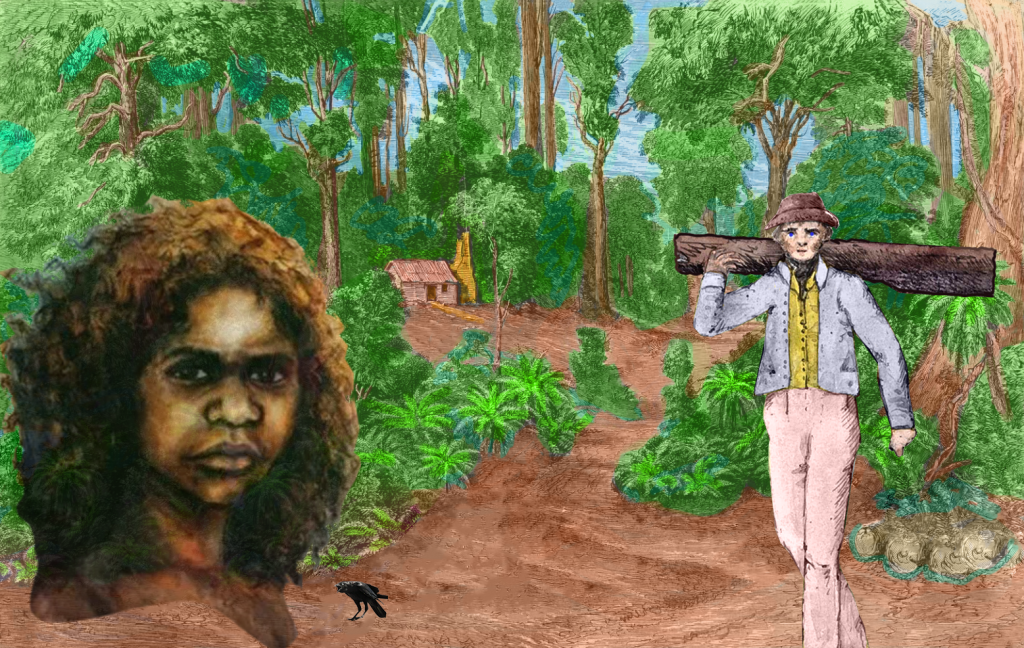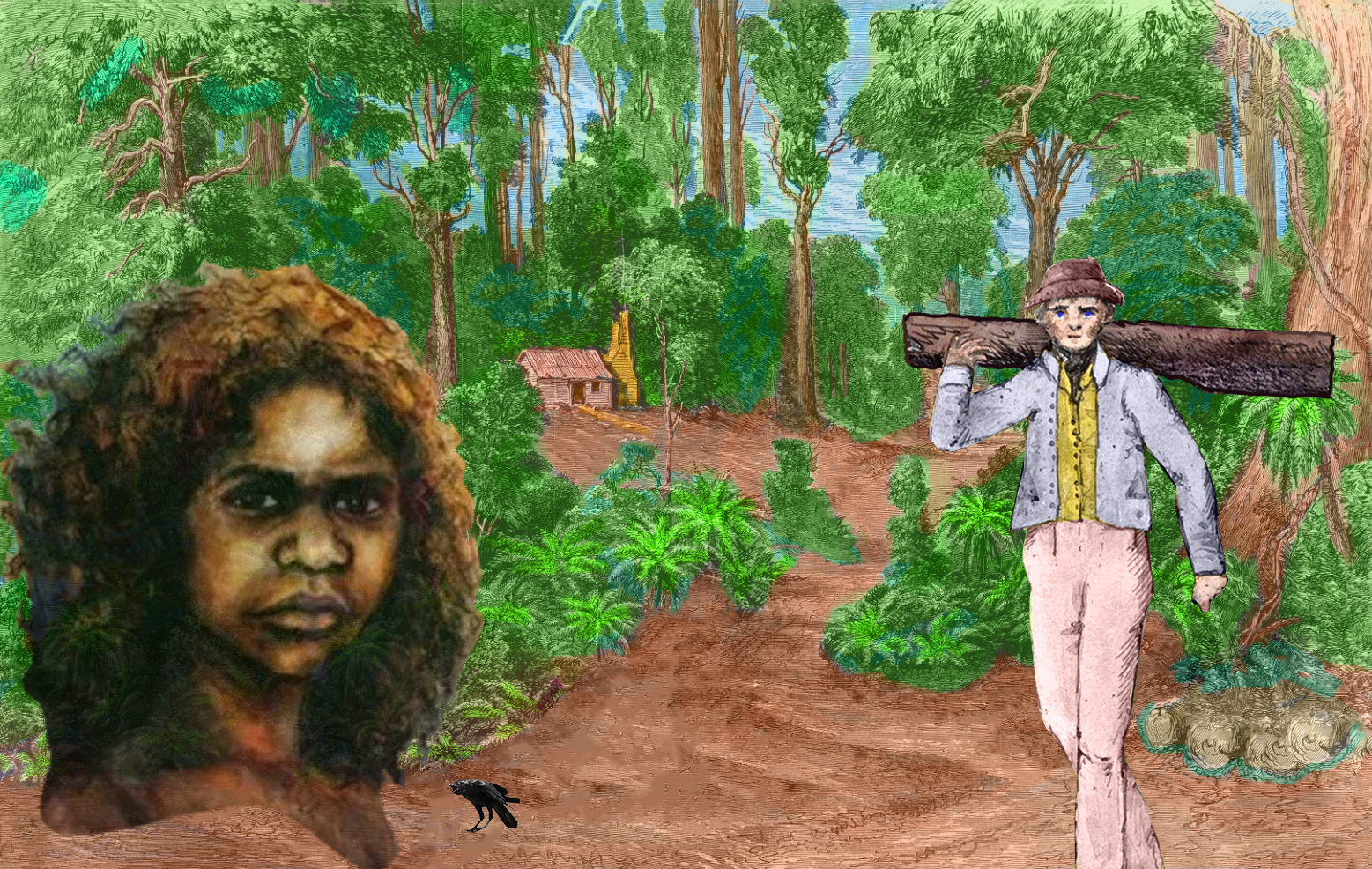Blackfella Maria Lock married a whitefella, a convict, who the government assigned to her

Blackfella Maria Lock lived a good life in Australia where she enjoyed peace, prosperity and happiness. Although the British with their armed protection had come charging into the landscape it did not stop her from having a happy childhood full of optimism and playful fun in the sunshine.
Not everyday of her life was free of depression and despair and initially living a life away from her kinfolk did give her feelings of emotional conflict and confusion.
Maria knew she had been given an opportunity to create a life based on her own value system developed through exposure to hunter gatherer and christian teachings. Maria understood the difference between the raging bull and the timid rabbit and worked out what life offered using two sets of eyes. She was the centre of her universe and free to do well. She worked very hard and was determined to align her stars into a pattern of her own creation. Continually being guided by her spirit meanderers and the callings of the crow which she often watched frolicking on the ground.
When she met Robert Lock she knew they were kindred spirits, like-minded and soul connected they were people with whom an instant connection of love and understanding was mutually experienced. Both wanted to leave their impoverished life behind and build a prosperous life on offer to hand onto their future generations.
In New South Wales prior to 1856, birth records were collected by church parishes so it is rare to find local native records of birth.
Although the actual date will never be known in around 1805 at Richmond Bottoms, on the eastern side of the Hawkesbury River an Australian girl was born. Yarramundi an elder ‘chief’ of the Boonooberongal local native clan was her father. The history books on the shelf do not say who her mother was or what maternal ancestry she had. It is assumed her mother was of pure local native ancestry.
In 1814 following a short conversation with Governor Macquarie, Yellomundee happily placed his daughter Bolongaia in the care of William Shelley and his wife Elizabeth. William Shelley was the headmaster and superintendent of the Native Institution.
William Shelley was a former London Missionary Society missionary.
On 10 December 1814 the Native Institute was launched at Parramatta by Governor Lachlan Macquarie as a school for the education of the local native children. Today, some people label the school as a children’s home and asylum. In 1823 the education facility was relocated to Blacktown. Ten years later the facility was closed.
Maria Lock was one of the first students to attend the Native Institute where she excelled in learning and in 1819 took out first prize to ‘excel in the early rudiments of education, moral and religious‘ study in the NSW Anniversary Schools Examination, her performance was the best of 120 children. 20 blackfella and 100 whitefella children.
By 1822, aged about 17 years, Maria was living at Parramatta in the home of the Reverend Thomas Hassall with his wife Anne who treated her like a daughter. Although there are no official records it was around this time she married Dicky, the son of Bennelong. Dicky died very soon after they married.
Around 1823 Maria was working in the household kitchen of Governor King where she met Robert Lock an Anglo-Saxon illiterate convict skilled in carpentry. Robert and his father Jonathon were convict carpenters involved in the construction of a new Native Institute building at Blacktown.
On 26 January 1824, Maria, aged around 19 years, married the 5’ 6” tall fair complexion with sandy hair Robert Lock who was a serving a seven year sentence. Their marriage was the first officially sanctioned wedding between a young local native woman and a British convict. Maria was an educated blackfella woman and Robert was an illiterate whitefella man.
As a ‘Marriage Portion’ Maria was promised a ‘small grant of land and a cow’. While she received the cow without any fuss she had to petition the governor before she received a grant of land.
We see in the new Australian society that the daughter of local native elder Yellomundee, Bolongaia became an educated woman who went on to marry a British convict who was assigned to her. Maria’s early grasp of the English language and her later above-average educational performance tells a story that she was included in early and continuous interaction with New South Wales whitefella society.
After their wedding Maria and Robert settled on one of the farms allotted to local native married couples, at Black Town adjoining the Native Institute. A rustic timber hut on cleared and fenced four acres was their home. After a year they moved to beside the Cabramatta Creek on Reverend Cartwright’s farm at Liverpool.
In February 1833, Maria received the first land grant given to a local native woman in the colony, forty acres at along Brickmakers Creek to the current Council Chambers in the name of Robert Lock.
“in Trust for the said Maria Lock during her life for the sole and separate use without the control of her present or future husband she may have and remain in trust for the Heirs of the said Maria Lock by you her present husband the said Robert Lock begotten.”
Maria received title to her local native deceased brother Coley’s 30 acre land grant in 1843 and received a further thirty-acre land grant in 1843. The couple returned to Blacktown in 1844 to settle on one of the farms allocated to local native married couples.
Robert and Maria had ten children. Nine survived to adulthood.
After 30 years of marriage Robert Lock died, aged 53 years, on 23 August 1854. Maria lived on for another 24 years and when she died their nine surviving children inherited all her land, which was divided equally between them.
Maria died on 6 July 1878 in her seventies at Windsor and was buried beside her husband Robert at St Bartholomew’s Church of England, Prospect.
In the burial register of St Bartholomew’s Church of England in Prospect, in black slightly smudged ink, the words ‘Last of the aboriginals from Blacktown’ is written.
The inherited land was lived on by her children and their descendants. In 1920 the land was converted to be an Aboriginal reserve (Plumpton).
